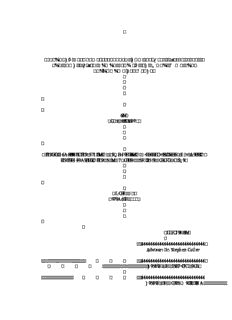
secondary metabolites isolated from perovskia atriplicifolia and their in vitro binding affinity for PDF
Preview secondary metabolites isolated from perovskia atriplicifolia and their in vitro binding affinity for
SECONDARY METABOLITES ISOLATED FROM PEROVSKIA ATRIPLICIFOLIA AND THEIR IN VITRO BINDING AFFINITY FOR HUMAN OPIOID AND CANNABINOID RECEPTORS by Ashli Fitzpatrick A thesis submitted to the faculty of The University of Mississippi in partial fulfillment of the requirements of the Sally McDonnell Barksdale Honors College Oxford, MS December 2014 Approved by ____________________________ Advisor: Dr. Stephen Cutler ____________________________ Reader: Dr. Francisco Leon ____________________________ Reader: Dr. Donna West-Strum ©2014 Ashli Fitzpatrick ALL RIGHTS RESERVED ii ACKNOWLEDGEMENTS I would like to thank my advisor Dr. Stephen Cutler and Dr. Francisco Leon for all of their devoted time, encouragement, and guidance through this meticulous process. I greatly appreciate Dr. Cutler for allowing me to work in his laboratory and giving me the resources I needed to complete this thesis project. I would like to thank Dr. Leon for guiding me through the experimental procedures involved and explaining all of the scientific literature and procedures in great detail. I would like to thank Dr. Debra Young and the Sally McDonnell Barksdale Honors College for giving me the opportunity to complete such an interesting research project and providing resources and encouragement during stressful times. I would lastly like to thank my family and friends for their unyielding support. I could not have completed this thesis without them. 3 ABSTRACT ASHLI FITZPATRICK: Secondary Metabolites Isolated from Perovskia atriplicifolia and Their In Vitro Binding Affinity for Human Opioid and Cannabinoid Receptors (Under direction of Dr. Stephen Cutler) Plants and their natural products have been utilized for thousands of years in the treatment of many human diseases. Because of their structural diversity, natural products are ideal lead compounds for drug development. In this thesis, the natural products of the plant Perovskia atriplicifolia were investigated, specifically their in vitro binding affinity to receptors in opioid and cannabinoid classes. Extracts that demonstrated good selective opioid and cannabinoid receptor binding were subjected to bioassay-guided fractionation. Four active compounds were identified from the crude extract in Perovskia atriplicifolia: 1) 5-hydroxy-3’,4’,6,7-tetramethoxy flavone, 2) 5,7-dihydroxy-3’,4’,6,-trimethoxy flavone, 3) 5-hydroxy-4’,6,7-trimethoxy flavone, and 4) 5,7-dihydroxy-4’,6,-dimethoxy flavone. Each compound exhibited good selective δ-opioid receptor binding affinity and was characterized as a flavanoid. 4 TABLE OF CONTENTS LIST OF TABLES AND FIGURES………………………………………………….....vi LIST OF ABBREVIATIONS………………………………………………………….viii BACKGROUND………………………………………………………………….............1 MATERIALS AND METHODS………………………………………………………..30 RESULTS………………………………………………………………………………..35 CONCLUSION…………………………………………………………………………..47 BIBLIOGRAPHY………………………………………………………………………..48 APPENDIX………………………………………………………………………………53 5 LIST OF TABLES AND FIGURES Figure 1 Chemical structure of paclitaxel 1……………………...………………3 Figure 2 Some important natural products……………………………………….4 Figure 3 Chemical structure of penicillin core…………………………………..5 Figure 4 Chemical structure of some terpenoids and sterols isolated from Perovskia species……………………………………………………...10 Figure 5 Photo of Perovskia atriplicifolia……………………………………....11 Figure 6 Major monoterpenes identified in P. atriplicifolia…………………....12 Figure 7 Perovstatone A isolated from P. atriplicifolia…………………...……12 Figure 8 Selective opioid receptor agonists and antagonists……………………16 Figure 9 Opioid receptor mechanism…………………………………………...18 Figure 10 Major sites of opioid receptors and endogenous opioid production…..20 Figure 11 Chemical structure of Δ9-tetrahydrocannabinol (THC)……………....23 Figure 12 Cannabinoid receptor agonists and antagonists……………………….23 Figure 13 Location of cannabinoid receptors in the human brain………………..25 Figure 14 Structure of cannabinoid receptors, CB and CB …………………….26 1 2 Figure 15 Initial steps and activity for P. atriplicifolia………………………......36 Figure 16 Fractionation of P. atriplicifolia………………………………………38 Figure 17 TLC plate for fraction 4………………………………………………39 Figure 18 Fractionation for fraction 5 of P. atriplicifolia………………………..41 Figure 19 1H NMR spectrum of 5-hydroxy-3’,4’,6,7-tetramethoxy flavone…….42 Figure 20 13C NMR spectrum of 5-hydroxy-3’,4’,6,7-tetramethoxy flavone…...43 Figure 21 5-hydroxy-3’,4’,6,7-tetramethoxy flavone, compound A…………….44 Figure 22 5,7-dihydroxy-3’,4’,6,-trimethoxy flavone, compound B………….…44 6 Figure 23 1H NMR spectrum of 5-hydroxy-4’,6,7-trimethoxy flavone…………45 Figure 24 5-hydroxy-4’,6,7-trimethoxy flavone, compound C………………….45 Figure 25 5,7-dihydroxy-3’,4’,6,-trimethoxy flavone, compound D…………....46 Table 1 Selective opioid receptor ligands……………………………………...17 Table 2 % of displacement of radioligands for subfractions obtained for fraction 4 of P. atriplicifolia……………………………………………………39 7 LIST OF ABBREVIATIONS ADH Antidiuretic Hormone BCE Before Christian Era CNS Central Nervous System COSY Correlation Spectroscopy DEPT Distortionless Enhancement by Polarization Transfer DMEM Dublecco’s Modified Eagle Medium DNA Deoxyribonucleic acid DOR Delta opioid receptors EtOAc Ethyl Acetate FDA Food and Drug Administration GPCRs G-protein Coupled Receptors HMBC Heteronuclear Multiple Bond Coherence HMQC Heteronuclear Multiple Quantum Coherence HMRS High-resolution mass spectra IASP International Association for the Study of Pain KOR Kappa opioid receptor MeOH Methanol MOR Mu opioid receptor NCE New Chemical Entity NCI National Cancer Institute NIH National Institute of Health NMR Nuclear Magnetic Resonance 8 NOESY Nuclear Overhauser Effect Spectroscopy NOR Nociceptin opioid receptor OGFr Opioid growth factor receptor THC Δ9-tetrahydrocannabinol TLC Thin-layer Chromatography TMS Trimethylsilane TOSCY Total Correlated Spectroscopy VLC Vacuum Liquid Chromatography WHO World Health Organization 9 Background I. Natural Products as a Resource for Drug Discovery Natural products, also known as secondary metabolites, refer to chemical compounds or substances produced by living organisms such as plants, animals, or microbes (Clement, 2005). Primary metabolites, which include glucose, DNA, and amino acids, are chemically identical in nearly all organisms and are required for normal development and growth of the organisms (Clement, 2005). Unlike primary metabolites, secondary metabolites are not directly required by an organism, are typically unique to a specific species or subset of a species, and can offer novelty in structure or function (Amsler et al., 2011). Secondary metabolites are synthesized primarily from the compounds acetate, mevalonate, shikimate, and various amino acids (Gao, 2010). Because these compounds are also used in the synthesis of essential primary metabolites, it is theorized that the excess compounds were utilized to create non-essential natural products (Gao, 2010). Natural products are created in nature and have naturally evolved with their producers, resulting in biological activity that is increasingly useful and effective (Gao, 2010). Natural product structures are extremely diverse and have high binding affinities to their specific receptor type (Gao, 2010). Because of their structural diversity and receptor binding activity, natural products are ideal bioactive lead compounds for drug development (Kingston, 2012). Plants and their natural products have formed the foundation of complex traditional medicine systems and have been a major source of curative products for thousands of 1
Description: